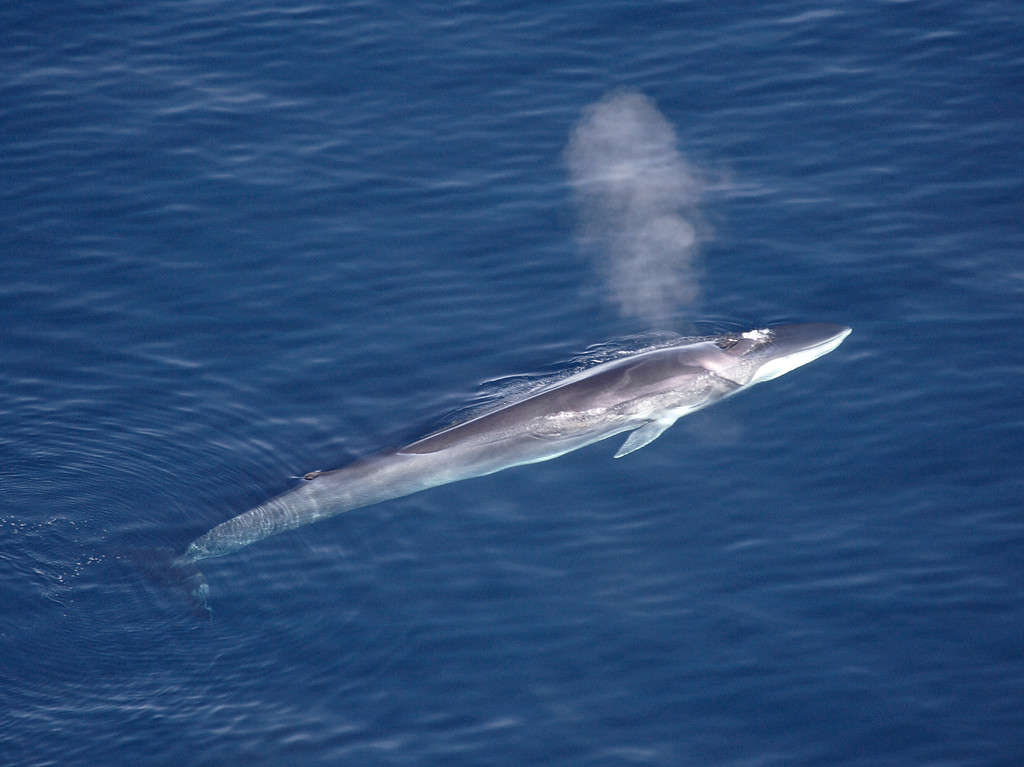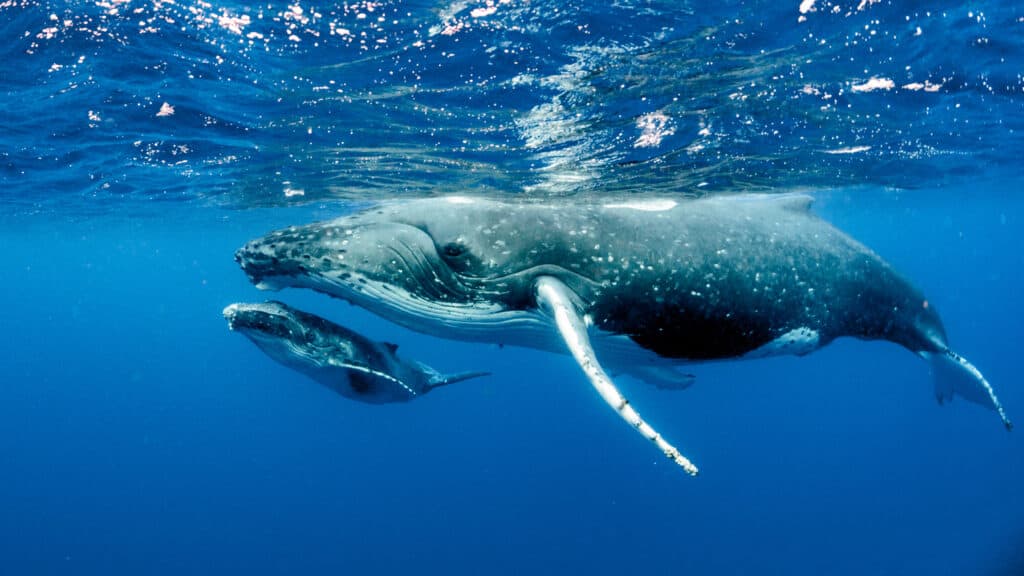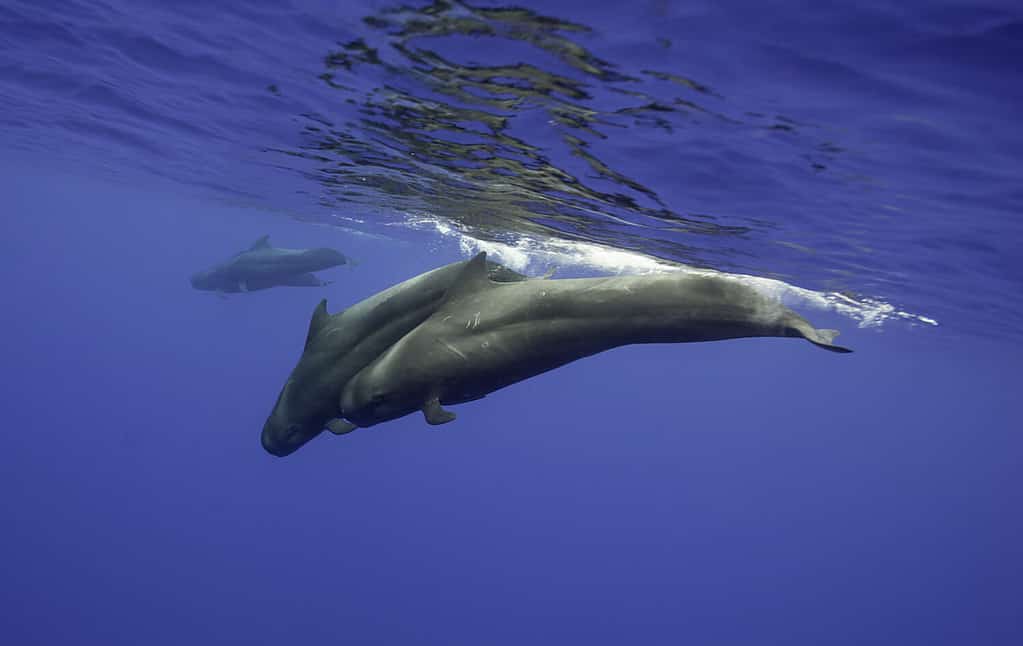Situated next to Massachusetts, Buzzards Bay is a one-of-a-kind expanse of the Atlantic Ocean. It covers roughly 28 miles in length and 8 miles across. This vast marine haven is not only a feast for the eyes but also a lively ecosystem teeming with various aquatic species. It is a dream destination for those who love nature and are intrigued by the ocean’s mysteries. Although it’s rare to spot them, witnessing the whales in this area is an incredibly moving experience. This article will shed light on some of the extraordinary whale species you might encounter while navigating the waters of Buzzards Bay.
1. Fin Whale (Balaenoptera physalus)

Fin whales are one whale you might be able to spot in Buzzards Bay.
©Aqqa Rosing-Asvid – Visit Greenland, CC BY 2.0 – License
One whale species that has been sighted in Buzzards Bay is the fin whale. It was swimming about two-thirds of the way from Mattapoisett to Woods Hole. Based on photos and videos, it seems that this particular whale was around 70 feet long. It also appeared to be in a weakened condition as its spine was noticeable. This observation suggested that the whale was likely in Buzzards Bay to feed on the abundant baitfish found in the area.
The waters off Massachusetts serve as a significant feeding area for fin whales along the U.S. east coast. Studies using photo-identification have indicated that fin whales may stay in the waters off Massachusetts for several months, which increases the likelihood of spotting them in Buzzards Bay. Although it is more typical for them to have shorter stays, ranging from a few days to several weeks.
Appearance
Characterized by their streamlined bodies and V-shaped heads, fin whales have a prominent, curved dorsal fin, running almost two-thirds down their backs, which rises gradually from their body. Their unique coloration includes a black or dark brownish-gray back and sides, contrasted with a white underside.
Size and Diet
In terms of size, the fin whale is second only to the blue whale. This makes the fin whale the second-largest whale species globally. The largest fin whales can reach up to 85 feet long. But they’ll generally grow to 70 to 73 feet on average. They typically feed on tiny fish, squid, and krill by lunging into schools of prey with their jaws open.
Habitat
Typically residing in the deep, open waters across all major oceans, fin whales are predominantly located in regions from temperate to polar latitudes. They hold the record for being the fastest among the large whales, able to achieve speeds of up to 23 to 25 miles per hour.
Conservation Status
Unfortunately, due to extensive hunting in the 20th century, they are currently an endangered species.
2. North Atlantic Right Whale (Eubalaena glacialis)

The North Atlantic right whale can grow up to 52 feet long.
©iStock.com/6381380
Another whale that you might spot in Buzzards Bay is the North Atlantic right whale. These whales frequently swim around in small groups around Cape Cod Bay and the Great South Channel to the east of Nantucket Island. The best opportunity to see them is from December to March, although April and May have a greater likelihood of getting more of them. These locations are significant because they contain a large number of microscopic floating animals known as zooplankton, which these whales like to eat.
Appearance
The North Atlantic right whale has a robust black body, lacks a dorsal fin, and has a blow spout that resembles a “V” shape. Their tails are wide, have a deep notch, and are entirely black with a smooth trailing edge. Their bellies can either be completely black or feature irregular white patches.
Size and Diet
Newborns are approximately 15 feet long, whereas fully grown adults can extend to 52 feet. These whales mainly consume small creatures such as zooplankton, krill, and other diminutive crustaceans. They filter these tiny organisms from the water using their baleen plates, which are similar to brushes and are located inside their mouths.
Habitat
The National Oceanic and Atmospheric Administration (NOAA) Fisheries has pinpointed two key habitats for the North Atlantic right whales that are crucial for their feeding, nurturing, and birthing activities. One area stretches from Cape Fear in North Carolina to just south of Cape Canaveral in Florida, which is mainly for calving. Another area is located off the coast of New England, which is primarily for foraging.
Conservation Status
Under the Endangered Species Act, the North Atlantic Right Whale has been classified as an endangered species since 1970. The latest preliminary data indicates that the population is now less than 350, including fewer than 70 females capable of breeding.
Regrettably, calve births in the past few years have fallen short of the expected average.
3. Humpback Whale (Megaptera novaeangliae)

The best time to spot humpback whales in Buzzards Bay is from May to October.
©Imagine Earth Photography/Shutterstock.com
It’s common to see humpback whales in the Massachusetts waters. They are a major attraction for the state due to their tolerance of whale-watching boats and their theatrical displays, which include flipper slapping, breaching, and sky-hopping.
The best months for whale viewing in Boston, and perhaps spotting them in Buzzards Bay as well, are from May through October, when their presence in the area is at its peak. Several whale species, including humpbacks, fin, and minke whales, migrate to the seas surrounding Massachusetts for feeding during this period.
These whales embark on one of the lengthiest migrations known among mammals, with some groups covering a distance of 5,000 miles between the areas where they breed and where they feed.
Appearance
The bodies of humpback whales are usually dark grey or black, with white spots on the belly, pectoral fins, and the underside of the tail flukes. These distinguishing black-and-white patterns are unique for each whale, just like human fingerprints. Humpback whales are very active animals, frequently smacking their flippers and flukes on the water’s surface.
Size and Diet
These whales, members of the baleen whale family, can grow to be up to 62 feet long. Their food consists primarily of krill, fish, and plankton, and they are capable of ingesting massive volumes of krill — up to a ton in a single day.
Habitat
Humpback whales are incredible creatures that grace both chilly polar and balmy tropical waters with their majestic presence. They love to roam in the Atlantic, Arctic, and Pacific Oceans, and their wanderlust even takes them to the Bering Sea and the enchanting waters encircling Antarctica.
Conservation Status
Unfortunately, humpback whale populations were severely impacted by whaling, leading to their current status as an endangered species in the United States.
4. Minke Whale (Balaenoptera acutorostrata)

A relatively common sight in the North Atlantic Ocean, minke whales may swim around in Buzzards Bay.
©Tim Watters/Shutterstock.com
Minke whales are frequently sighted in the North Atlantic Ocean, and there is a possibility of seeing one in Buzzards Bay. Like humpback whales, minkes are most active between May and October, which is when they are most often observed in this area. In fact, it’s also possible that this is the most frequently seen whale species on Stellwagen Bank and Jeffrey’s Ledge.
Minkes share a trait with humpbacks: curiosity. Minke whales often approach stationary boats, providing an awe-inspiring, close-up encounter. Interestingly, a nickname for minke whales is “stinky minkes” due to the unpleasant odor of their breath.
Appearance
Minke whales sport a gently curved dorsal fin that rises around two-thirds down their back. Their bodies boast shades of dark black to grayish-brown, highlighted by a light chevron located on their back, just behind their head and above their flippers. This striking contrast is complemented by their pure white underbellies. Young calves tend to have a darker hue than adults.
Size and Diet
Minke whales are quite common and are the smallest member of the baleen whale family. They swim around in North American waters. A minke whale can grow up to approximately 35 feet, with females potentially being a bit larger than males. Their diet is diverse, including plankton, crustaceans, and small fish that swim in groups.
Habitat
While minke whales tend to favor temperate to boreal waters, they’re not ones to shy away from tropical and subtropical realms either. They typically feed in the cooler waters found at higher latitudes and swim in both coastal regions and further out at sea.
Conservation Status
In the United States, minke whales are not considered to be in danger, which is good news. They are kept safe by a law called the Marine Mammal Protection Act. The people at NOAA Fisheries, along with their partners, are working hard to make sure minke whales stay safe.
5. Pilot Whale (Globicephala)

Pilot whales follow a “pilot” or leader in their group.
©wildestanimal/Shutterstock.com
The final whale on this list is the pilot whale, a species that has, unfortunately, been involved in numerous strandings on the beaches of Massachusetts, signaling its presence in the waters near Buzzards Bay. Pilot whales are observed almost every year near Buzzards Bay, typically in the late summer and throughout the fall season.
The name “pilot whale” stems from the fact that each group, or pod, of these whales follows a “pilot” or a leader within the group.
Appearance
There are two varieties of pilot whales in the United States, each has a round forehead, a short nose that looks like a beak, and thin, pointed flippers. Apart from flipper length, the long-finned pilot whale (Globicephala melas) and short-finned pilot whale (Globicephala macrorhynchus) seem quite similar.
Size & Diet
Pilot whales can measure anywhere from 13 to 20 feet. The males are usually bigger than the females. Pilot whales with shorter fins mainly eat squid but might also feed on octopus and fish found in relatively deep waters of 1,000 feet or more. Long-finned pilot whales, on the other hand, may dive to depths of roughly 2,000 feet for 10 to 16 minutes to feed on fish, cephalopods, and crustaceans.
Habitat
These whales are usually near the continental shelf’s coast. Some populations, though, have been extending into the deep, open ocean environments, such as in the eastern tropical Pacific Ocean. The reasons for their frequent involvement in mass strandings remain unclear.
Conservation Status
While we can’t pinpoint the exact count of pilot whales in existence, they aren’t currently classified as endangered. Estimations propose a global population of roughly 1 million long-finned pilot whales and around 200,000 short-finned pilot whales. Similar to their marine peers, pilot whales receive protection through the Marine Mammal Protection Act.
Summary of Amazing Whales You Might Spot in Buzzards Bay
| Number | Whale | Scientific Name |
|---|---|---|
| 1 | Fin Whale | Balaenoptera physalus |
| 2 | North Atlantic Right Whale | Eubalaena glacialis |
| 3 | Humpback Whale | Megaptera novaeangliae |
| 4 | Minke Whale | Balaenoptera acutorostrata |
| 5 | Pilot Whale | Globicephala |
The photo featured at the top of this post is © Imagine Earth Photography/Shutterstock.com
Thank you for reading! Have some feedback for us? Contact the AZ Animals editorial team.






